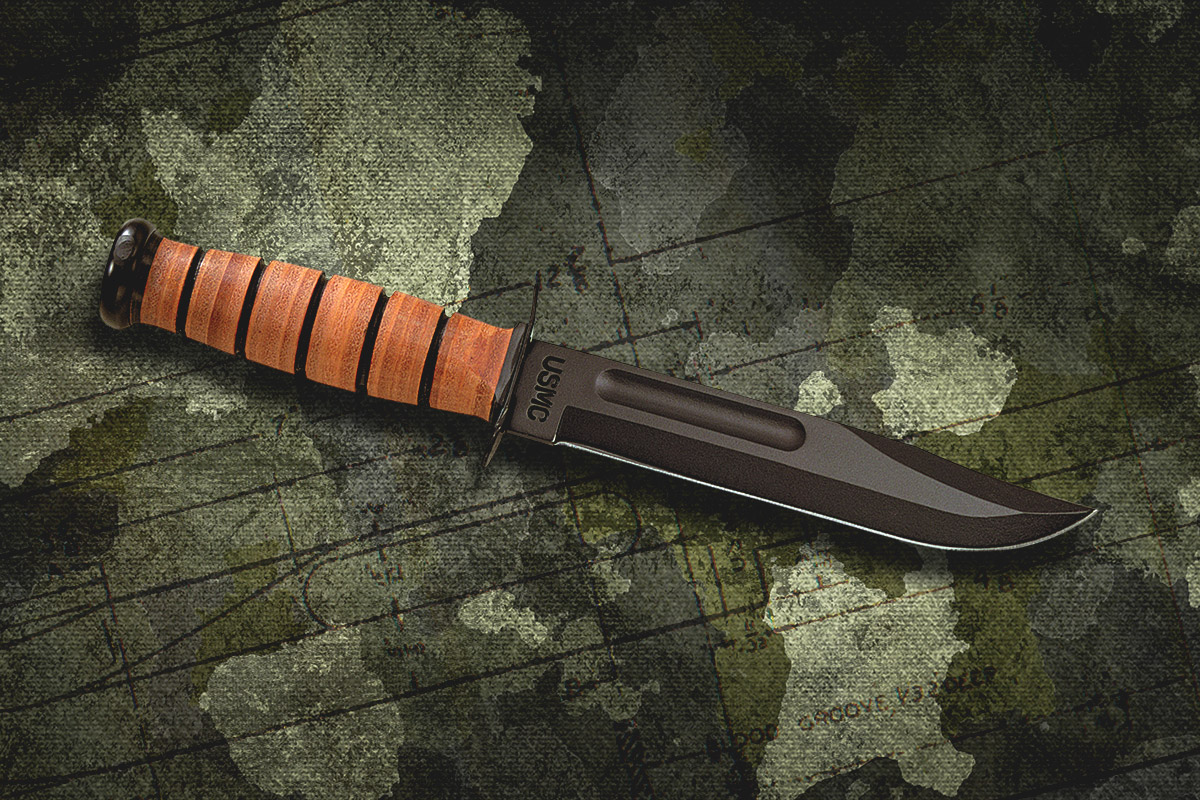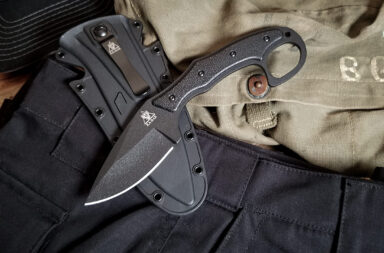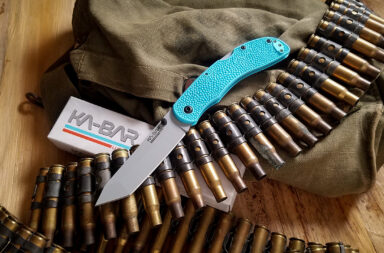After the United States’ entry into World War II, complaints arose from Army soldiers and Marines issued World War I-era bronze or alloy-handled trench knives such as the U.S. Mark I trench knife for use in hand-to-hand fighting. The Mark I was relatively expensive and time-consuming to manufacture, and reports from the field indicated that the knife’s large ‘brass-knuckle’ fingerguard handle made it difficult to secure in conventional scabbards while limiting the range of useful fighting grip positions. Another criticism was that the Mark I’s relatively thin blade was prone to breakage when used for common utility tasks such as cutting wire or opening ammunition crates and ration cans. A final impetus came from the War Department, which had determined the need for a new multipurpose knife capable of fulfilling the roles of both a fighting and a utility knife, while at the same time conserving strategic metal resources.
The Marine Corps authorized limited issuance of a fighting knife with a stiletto blade design, the Marine Raider Stiletto designed by Lt. Col. Clifford H. Shuey, a Marine Corps engineering officer. Shuey’s pattern was essentially a copy of the Fairbairn–Sykes fighting knife with altered material specifications designed to reduce dependence on critical strategic metals. The Raider stiletto was initially issued to elite Marine forces, including the entire 1st Marine Raider Battalion commanded by Colonel Merritt A. Edson, the USMC 1st Parachute Battalion, and to Marines of the 2nd Marine Raider Battalion commanded by Lt. Col. Evans F. Carlson. Primarily intended as a thrusting (stabbing) weapon, the Marines of the 1st Raider battalion found the Raider stiletto to be well designed for silent killing, but was of little use for any other purpose, and too frail for general utility tasks. After their first combat, many Marines in the 2nd Raider Battalion exchanged their Raider stilettos for No. 17 and No. 18 Collins general-purpose short machetes (machetes pequeños) purchased with unit funds. The Collins machetes, which superficially resembled a large Bowie knife, were also issued to some Army air crews as part of the Jungle Emergency Sustenance Kit of 1939.
In the absence of suitable officially issued knives, a number of Marines deploying for combat in 1942 obtained their personal knives through private purchase, usually hunting/utility patterns such as Western States Cutlery Co.’s pre-war L76 and L77 pattern knives, both of which had 7-inch (180 mm) Bowie type clip blades and leather handles. The Western States L77 was stocked at the San Diego Base Exchange at the onset of the war, and knives of this pattern were carried by many Marines in the 1st Marine Division as well as by Marine Raiders in the 2nd Marine Raider Battalion commanded by Lt. Col. Evans F. Carlson.
In response to a specification requesting a modern individual fighting knife design for the U.S. Marines, ordnance and quartermaster officials requested submissions from several military knife and tool suppliers to develop a suitable fighting and utility knife for individual Marines, using the U.S. Navy Mark 1 utility knife and existing civilian hunting/utility knives such as Western’s L77 as a basis for further improvements. Working with Union Cutlery, USMC Colonel John M. Davis and Major Howard E. America contributed several important changes, including a longer, stronger blade, the introduction of a small fuller to lighten the blade, a peened pommel (later replaced by a pinned pommel), a straight (later, slightly curved) steel crossguard, and a stacked leather handle for better grip. The blade, guard, and pommel were coated with a non-reflective matte phosphate finish instead of the brightly polished steel of the original prototype. The design was given the designation of 1219C2. Notably, the 1219C2 used a thicker blade stock than that of the USN Mark 1 utility knife, and featured a stout clip point. After extensive trials, the 1219C2 prototype was recommended for adoption. The Marines’ Quartermaster at the time initially refused to order the knives, but his decision was overruled by the Commandant. The Marine Corps adopted the new knife on November 23, 1942, still under the designation 1219C2.
The 1219C2 proved easy to manufacture; the first production run was shipped by Camillus Cutlery Company on January 27, 1943. After the U.S. Navy became disenchanted with blade failures on the USN Mark 1 utility knife, the latter service adopted the 1219C2 as the US Navy Utility Knife, Mark 2. The Marine Corps in turn re-designated the 1219C2 as either the USMC Mark 2 Combat Knife, or simply the Knife, Fighting Utility. In naval service, the knife was used as a diving and utility knife from late 1943 onward, though the stacked leather handle tended to rot and disintegrate rapidly in saltwater.
The Marine Corps issued USMC Mark 2 combat/fighting utility knife throughout Marine forces, with early deliveries going primarily to elite formations. In late 1943 the 1219C2 replaced the Marine Raider Stiletto in service, a change welcomed by the marines of Col. Edson’s 1st Raider Battalion, who found the Raider stiletto ideal for silent killing but of little use for anything else. As the knife went into large-scale production, the Marines issued the Mark 2 Combat/Fighting Utility knife to reconnaissance and engineering units and to any Marine armed with the pistol, M1 carbine, BAR, or crew-served machine gun (rifle-armed Marines were typically issued a bayonet). Marines were often issued knives with “U.S.N. Mark 2” markings when Navy-issued Mark 2 knives were all that was available. By 1944 the USMC Mark 2 Combat/Fighting Utility knife was issued to virtually any Marine in the combat branches who desired one, and was in use by Marine Corps close combat instructors for training new recruits. Unlike the prior Marine Raider stiletto, Marines were taught to use their new knife primarily as a slashing weapon in the initial phases of hand-to-hand combat.

As its new name implied, the “Knife, Fighting Utility” was designed from the outset as a dual-purpose knife: it was both an effective combat knife and a utility tool, well-suited to the type of jungle warfare encountered by Marines in the Pacific theater. This dual-purpose design resulted in some initial criticism of the pattern as being less than ideal for knife fighting, but combat experience of returning veterans as well as reports from the battlefield soon dispelled any doubts about its combat effectiveness.
After the Second World War, the U.S. Navy and Marine Corps continued to use the Mark 2 Combat/Fighting Utility knife. In addition to military contract knives, the knife was produced for the civilian market, and the pattern enjoyed some popularity as a general-purpose hunting and utility knife.
The KA-BAR USMC gives Union Cutlery a brand new name
The Union Cutlery Company, the first company to manufacture a knife trademarked KA-BAR, was founded in 1897 as the Tidioute Cutlery Co. The Tidioute Cutlery Co. was dissolved and its assets taken over by Wallace R. Brown, who renamed the company Union Razor Co. which shortly thereafter became the Union Cutlery Company in 1909, headquartered in Olean, New York.
“KA-BAR” was a trademark of one of the four wartime manufacturers, Union Cutlery Co. and had been used on several of their previous knives since 1923.They stamped this trademark on the ricasso of all the Mark 2 knives they produced – and were second only to Camillus in terms of production, producing about 1 million knives during the wartime contract. Marines as early as 1944 began universally referring to their new combat knife as the “KA-BAR”, regardless of manufacturer. The popular designation of the knife may also have resulted from contact with Marine Corps close combat instructors in San Diego, who appear to have used the term “KA-BAR” when training recruits in the skill of knife fighting.
From 1923 until 1952, KA-BAR remained a legal trademark of Union Cutlery Company. However, in 1952 Union Cutlery renamed itself KA-BAR Cutlery Inc. in order to capitalize on widespread public recognition of the name and trademark, which had by then become synonymous with the Mark 2 Combat Knife. While the company name changed, KA-BAR, Inc.’s headquarters are still located in Olean, New York.
This article was excerpted from Wikipedia. The original is here: https://en.wikipedia.org/wiki/Ka-Bar
The KA-BAR USMC is still the best-selling knife for KA-BAR, you can get one of your own here by clicking the ‘Get one’ button below.




